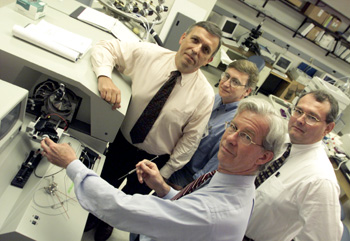
Dr. Raymond Burk (foreground) confers with Clinical Nutrition Research Unit investigators (from left) Dr. Richard Caprioli, Dr. David Ong and Dr. David Hachey. (photo by Mary Donaldson)
NIH grant bolsters nutrition center, core facilities
Vanderbilt’s Clinical Nutrition Research Unit (CNRU) recently received a five-year, $2.5 million NIH grant renewal that will keep the center’s six facility cores running through the year 2004.
The renewal makes Vanderbilt’s CNRU the longest continually funded nutrition research facility in the country receiving its funding from the National Institutes of Health (NIH).
The CNRU, established in 1979 by Dr. Harry Greene, is one of eight similar nutrition centers in the nation funded by the NIH. Currently the CNRU has 27 investigators and 8 pilot grant recipients.
Its mission is to support nutrition research, promote education, and to encourage translation of research to patient care at Vanderbilt.
“The current school of thought is that many of the prominent health problems facing us now are nutrition related,” said Dr. Raymond F. Burk, Professor of Medicine in Gastroenterology and Director of the CNRU.
Endemic health problems like heart disease, obesity and cancer are thought to be closely related to diet.
“Many people believe that dietary intake can either predispose you to certain diseases, or protect you from them with the help of different nutrients. Nutrition research is somewhat nebulous. There is no department of nutrition here at Vanderbilt, so the CNRU provides a tangible focus of research money and support from the NIH,” he said.
The CNRU’s core facilities and labs offer a wide variety of services, from amino acid analysis to precise measurement of a patient’s metabolic rate.
The Amino Acid Metabolism Lab, run by Paul J. Flakoll, Ph.D., research associate professor of Surgery and research assistant professor of Biochemistry, provides the methodology to measure amino acids. Larry L. Swift, Ph.D., professor of Pathology, oversees the Lipid Metabolism Lab. David L. Hachey, Ph.D., professor of Pharmacology, runs the Mass Spectrometry Lab. The Protein/Immunology Lab is run by David E. Ong, Ph.D., professor of Biochemistry.
The One-Carbon Metabolism Core, which does analysis of folic acid and vitamin B12, is overseen by Conrad Wagner, Ph.D., professor of Biochemistry. Kong Y. Chen, Ph.D., research instructor in Medicine and Gastroenterology, oversees the Energy Balance Core facilities, which include the Metabolic Chamber and Bod Pod. And Dr. Gordon L. Jensen, associate professor of Medicine, oversees nutritional assessment determining proper caloric intake for patients.
“One of the chief reasons that the NIH funds clinical nutrition research centers is to raise awareness of nutritional implications of ongoing research, and to entice investigators to do nutrition research by giving them support,” Burk said.
Part of the money provided by the NIH is set aside to fund nutrition-related research projects under the Pilot Project Program.
Burk cites research related to folic acid done by Dr. Mark J. Koury, professor of Medicine in Hematology/Oncology, as a good example. “He’s done really wonderful work with folic acid and the maturation of blood cells. He was not originally focused on nutrition, but received some support from the CNRU to do some pilot studies which led to some grants from the NIH and the VA,” he said. “Now, he is thinking of nutritional implications of his work.”
The CNRU’s Energy Balance Core facility is one of the most sophisticated in the world. Dr. Kong Chen oversees the Metabolic Chamber and the Bod Pod; both located in the Clinical Research Center in Medical Center North.
The Metabolic Chamber, one of only a half-dozen in the U.S., is a room that can precisely gauge a study participant’s metabolic rate and can measure energy consumption and work performed. The Bod Pod is a small chamber also located within the Clinical Research Center that can quickly provide an accurate body composition analysis.
Jensen, who heads the Nutritional Assessment Core Facility, is currently developing computer methods to accurately assess how much food people consume.
“This is a very difficult problem. If you ask someone how much they eat, it has been shown that a person’s perception of how much they eat varies,” Burk said. “There have been studies done with obese patients that demonstrate that they consistently underestimate how much they eat.”
The Amino Acid Core facility, overseen by Dr. Paul Flakoll, consists of a number of different methodologies to measure amino acids. “Amino acids are the building blocks of protein. Your protein metabolism depends on your having the right mix of amino acids,” Burk said.
Swift oversees the Lipid Metabolism Core facility. “He can carry out those sorts of analyses that an individual investigator is not likely to be able to do in his lab,” Burk said.
The CNRU’s Mass Spectrometry Core allows nutrition researchers, as well as several other departments that contribute to its operation, the ability to analyze lipids and proteins.
Dr. Conrad Wagner oversees the One-Carbon Metabolism Core facility. “One carbon metabolism has to do with folic acid and vitamin B12. Dr. Wagner and his associates have developed complex methodologies over the years that are a great help to our research,” Burk said. “They offer precise measurements that can’t be done elsewhere.”
Dr. David Ong runs the Protein & Immunology core, which provides protein chemistry which includes amino acid analysis of the proteins.
“We are very keen to promote nutrition research and we hope other investigators at Vanderbilt will look for nutrition applications for their work and avail themselves of the opportunities we have to support their research,” Burk said.
For more information about the Vanderbilt Clinical Nutrition Research Unit, and for information about the Pilot Project Grant Program, please visit the CNRU website at www.mc.vanderbilt.edu/nutrition/.













